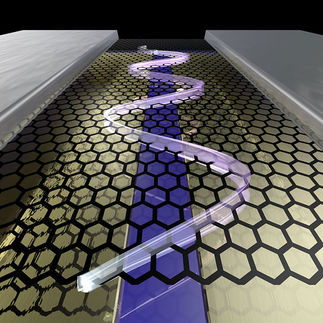Graphene is both transparent and opaque to radiation
Graphene ensures data fidelity for future wireless devices
EPFL and UNIGE scientists have developed a microchip using graphene that could help wireless telecommunications share data at a rate that is ten times faster than currently possible.
"Our graphene based microchip is an essential building block for faster wireless telecommunications in frequency bands that current mobile devices cannot access," says EPFL scientist Michele Tamagnone.
Graphene acts like polarized sunglasses
Their microchip works by protecting sources of wireless data -- which are essentially sources of invisible radiation -- from unwanted radiation, ensuring that the data remain intact by reducing source corruption.
They discovered that graphene can filter out radiation in much the same way as polarized glasses. The vibration of radiation has an orientation. Like polarized glasses, their graphene-based microchip makes sure that radiation that only vibrates a certain way gets through. In this way, graphene is both transparent and opaque to radiation, depending on the orientation of vibration and signal direction. The EPFL scientists and their colleagues from Geneva used this property to create a device known as an optical isolator.
Faster Uploads in the Terahertz Bandwidth
Moreover, their microchip works in a frequency band that is currently empty, called the Terahertz gap.
Wireless devices work today by transmitting data in the Gigahertz range or at optical frequencies. This is imposed by technological constraints, leaving the potential of the Terahertz band currently unexploited for data transmission.
But if wireless devices could use this Terahertz bandwidth, your future mobile phone could potentially send or receive data tens of times faster than now, meaning better sound quality, better image quality and faster uploads.
The graphene-based microchip brings this Terahertz technology a step closer to reality. This discovery addresses an important challenge that was so far unsolved due to lacking technologies, confirming once more the extraordinary physical properties of graphene.
Most read news
Other news from the department science

Get the chemical industry in your inbox
By submitting this form you agree that LUMITOS AG will send you the newsletter(s) selected above by email. Your data will not be passed on to third parties. Your data will be stored and processed in accordance with our data protection regulations. LUMITOS may contact you by email for the purpose of advertising or market and opinion surveys. You can revoke your consent at any time without giving reasons to LUMITOS AG, Ernst-Augustin-Str. 2, 12489 Berlin, Germany or by e-mail at revoke@lumitos.com with effect for the future. In addition, each email contains a link to unsubscribe from the corresponding newsletter.



























































